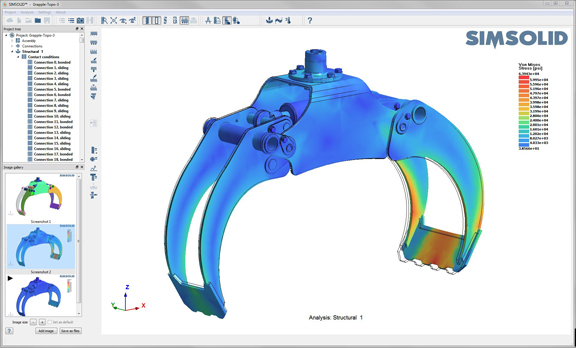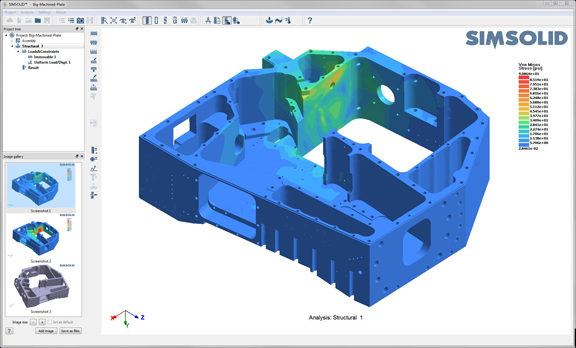
SIMSOLID, launched in December 2015, employs a mesh-less method to run analysis directly on CAD geometry, the company states.
January 15, 2016
 SIMSOLID is developed for assembly analysis; therefore, it has the ability to deduce the type of connectors required to join different parts, the company says.
SIMSOLID is developed for assembly analysis; therefore, it has the ability to deduce the type of connectors required to join different parts, the company says.
 SIMSOLID, launched in December 2015, employs a mesh-less method to run analysis directly on CAD geometry, the company states.
SIMSOLID, launched in December 2015, employs a mesh-less method to run analysis directly on CAD geometry, the company states.
Geometry meshing—subdividing a design into micro-elements—is usually the most compute-intense part of analysis. This is the part that pushes the processors to their limits. If you happen to be running finite element analysis (FEA) in an older system, this is where you'll most likely hear your CPUs whine and grumble. The more complex your model, the longer it takes to mesh.
The way to overcome this hurdle is to skip the meshing process altogether. That's the underlying principle of SIMSOLID, a new software that launched last December.
“CAD geometry and analysis geometry are different. That has always been a problem in doing analysis on CAD design,” said Ken Welch, cofounder and CEO of SIMSOLID. Meshing is part of the process to convert CAD geometry into an analysis-ready state.
Welch is a familiar figure in the CAD sector. Before reappearing at the helm of SIMSOLID, he held executive positions at MSC Software and Moldflow. “SIMSOLID uses a mesh-less method. It conducts analysis directly on CAD geometry, so you can take full advantage of the feature history in the model,” he explained.
In eliminating the meshing process, SIMSOLID also bypasses the need to simplify geometry, the removal of geometric features (like holes, bosses, and rounded corners) that don't affect the analysis outcome significantly. The so-called simplification process is not so simple, as it usually requires manual intervention from the user. Even if the software can semi-automatically identify such minor features, a user must still review them and decide to retain or remove them.
SIMSOLID is “the first analysis system that's written for assemblies,” according to Welch, “so it recognizes [typical assembly components such as] nuts, bolts, connectors, and holes, and can generate the appropriate connections.”
Running analysis on an assembly requires defining the connections—how different parts are joined or mated to one another. SIMSOLID's ability to deduce the appropriate connections from the geometry itself removes the need for the user to define them manually.
Welch revealed that the solver for SIMSOLID is developed to be highly parallel. Though it doesn't support GPU-accelerated mode, it's a possibility for the future.
The new approach employs by SIMSOLID cuts down many of the steps a user typically goes through to prepare the model before running analysis. That contributes to the product's uncharacteristically small footprint—a mere 33MB for local installation.
The company describes the software as “structural analysis software developed specifically for design engineers.” The software is available now as a free trial (30 days), or by subscription for $200 per month or $1,500 per year. It's also available as a plug-in through Onshape App Store, partner solutions that augment the browser-based CAD system Onshape.
Subscribe to our FREE magazine, FREE email newsletters or both!
About the Author
Kenneth Wong is Digital Engineering’s resident blogger and senior editor. Email him at [email protected] or share your thoughts on this article at digitaleng.news/facebook.
Follow DE





